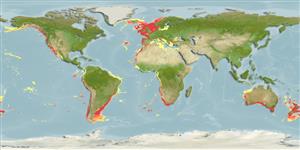分类 / Names
俗名 | 同种异名 | Catalog of Fishes(属, 种) | ITIS | CoL | WoRMS | Cloffa
Elasmobranchii
板鳃亚纲 (鲨鱼与 鱼) (sharks and rays) >
Carcharhiniformes (Ground sharks)
白眼鮫目 (Ground sharks) >
Triakidae (Houndsharks)
平滑鮫科 (Houndsharks) > Galeorhininae
Etymology: Galeorhinus: galeo, probably based on G. galeus (see below); rhinus, an ancient name for sharks, from rhine (Gr.), rasp, alluding to their rasp-like skin. (See ETYFish); galeus: From galeos, a small shark or dogfish per Aristotle (sometimes translated as weasel), possibly referring to the pointed snouts, swift movements and/or rapacious feeding behavior of smaller predatory sharks1. (See ETYFish).
More on author: Linnaeus.
Environment: milieu / climate zone / depth range / distribution range
生态学
海洋 底中水层性; 海洋洄游的 (Ref. 51243); 深度上下限 0 - 1100 m (Ref. 26346), usually 2 - 471 m (Ref. 43939). 亞熱帶的; 70°N - 58°S, 111°E - 37°E
World-wide in temperate waters (Ref. 58085). Western Atlantic: southern Brazil to Argentina. Eastern Atlantic: Iceland, Norway, Faeroe Islands, British Isles to the Mediterranean and Senegal; Namibia to South Africa (Western Indian Ocean). Western Pacific: Australia and New Zealand. Eastern Pacific: British Columbia (Canada) to southern Baja California, Gulf of California; Peru and Chile. Questionable records in Ivory Coast, Nigerai, Gabon to Congo Dem Rep and Laysan Is. (Hawaii) (Ref 244).
西大西洋: 巴西南部到阿根廷。 東大西洋: 冰島到南非, 包括地中海。 西印度洋: 南非。 西南太平洋: 澳洲與紐西蘭。 中太平洋: 夏威夷。 東太平洋: 到在墨西哥的下加利福尼亞南部與加州灣的加拿大卑詩省; 祕魯與智利。
Length at first maturity / 大小 / 重量 / 年龄
Maturity: Lm 144.1, range 120 - 185 cm
Max length : 193 cm TL 雄鱼/尚未辨别雌雄; (Ref. 40637); 195.0 cm TL (female); common length : 160 cm TL 雄鱼/尚未辨别雌雄; (Ref. 9258); 最大体重: 44.7 kg (Ref. 40637); 最大年龄: 55 年 (Ref. 6871)
背棘 (总数) : 0; 臀棘: 0. A large houndshark with a long, pointed snout, a large mouth, and small blade-like teeth; 2nd dorsal about as large as anal fin and terminal caudal lobe as long as rest of fin (Ref. 5578). Greyish above, white below; young with black markings on fins (Ref. 5578).
一个大的猎犬鲨具有一个长的,尖的吻, 一个大的嘴 , 与小的刀剑状的齿; 第二背鳍大约与臀鳍与末端的尾叶一样大长达其它的鳍。 (参考文献 5578) 背面略灰色的, 腹面白色的; 在鳍上幼鱼有黑色的斑纹。 (参考文献 5578)
Mainly demersal on continental and insular shelves, but also on the upper slopes, at depths from near shore to 550 m (Ref. 6871), but has been shown to be pelagic in the open ocean (frequently caught on floating tuna longlines over deep water, and many New Zealand-tagged specimens have been recaptured in Australia) (Ref. 26346). Occurs in small schools that are highly migratory in higher latitudes in their range (Ref. 244). There is pronounced partial segregation by size and sex in some areas (Ref. 244). Feeds on fishes (bottom as well as pelagic species, Ref. 26346), crustaceans, cephalopods, worms, and echinoderms (Ref. 244). Ovoviviparous (Ref. 50449). Targeted for human consumption, liver for squalene oil, fins for soup (Ref. 244); also utilized as fishmeal (Ref. 13563). Marketed fresh, dried-salted, and frozen (Ref. 9987). Adapts well in captivity if carefully captured and handled (Ref. 12951).
主要地栖息于大陆架与岛屿棚, 也捕食上层斜坡, 在深度从近岸到 550 公尺.(参考文献 6871) 曾经显示是大洋性的,在中开放性海域 (时常在深水域上的漂浮鲔鱼延绳钓上面捕获, 与许多新西兰附以签条的标本曾经在澳大利亚拿回了).(参考文献 26346) 形成小群鱼群那是高度迁移的在他们的范围中的较高的纬度.(参考文献 244) 有明显的部分分离依大小与在一些地区的性别.(参考文献 244) 吃鱼 (底部以及大洋性鱼种, 参考文献 26346) ,甲壳动物,头足类动物,蠕虫与棘皮动物。 (参考文献 244) 卵胎生的.(参考文献 50449) 它的肉是优良的供人类消费,肝脏用于 squalene 油,鳍用于汤;(参考文献 244) 也利用了制成鱼粉。 (参考文献 13563) 在市场上销售生鲜地了, 乾燥盐腌 , 与冷冻.(参考文献 9987) 如果小心地捕获而且触摸,适应得好在繁殖场。 (参考文献 12951)
Ovoviviparous, without a yolk-sac placenta (Ref. 244). Embryos feed solely on yolk (Ref. 50449). 6 to 52 young in a litter (Ref. 26346). Litter size increases with the size of the mother. Embryos reach 30-36 cm TL at birth (Ref. 6080). In the southern waters of Australia, newly born and older juveniles (30-70 cm long) aggregate in 'nursery areas' found in shallow waters.They move to deeper coastal waters to over-winter. The following spring finds most of these young returning to their nursery areas. The older ones, aged 2 years and over move instead to eastern Bass Strait where most of the immature stock are found. The length of an average full-term embryo is 32 cm. Spawning frequency is once every year, ovulation occurring in early summer and parturition is completed by January of the following year. Gestation period lasts for about 12 months (Ref. 6390, 6871).西大西洋: 巴西南部到阿根廷。 東大西洋: 冰島到南非, 包括地中海。 西印度洋: 南非。 西南太平洋: 澳洲與紐西蘭。 中太平洋: 夏威夷。 東太平洋: 到在墨西哥的下加利福尼亞南部與加州灣的加拿大卑詩省; 祕魯與智利。
Compagno, L.J.V., 1984. FAO Species Catalogue. Vol. 4. Sharks of the world. An annotated and illustrated catalogue of shark species known to date. Part 2 - Carcharhiniformes. FAO Fish. Synop. 125(4/2):251-655. Rome: FAO. (Ref. 244)
世界自然保护联盟红皮书 (Ref. 130435)
极度濒危 (CR) (A2bd); Date assessed: 14 February 2020
人类利用
渔业: 高经济性; 游钓鱼种: 是的; 水族馆: 公众的水族馆
工具
特别资料
下载 XML
网络资源
Estimates based on models
Preferred temperature (Ref.
123201): 6.7 - 23.2, mean 12.3 °C (based on 7314 cells).
Phylogenetic diversity index (Ref.
82804): PD
50 = 1.0000 [Uniqueness, from 0.5 = low to 2.0 = high].
Bayesian length-weight: a=0.00479 (0.00363 - 0.00631), b=2.99 (2.91 - 3.07), in cm total length, based on LWR estimates for this species (Ref.
93245).
营养阶层 (Ref.
69278): 4.3 ±0.1 se; based on diet studies.
Generation time: 11.9 (6.9 - 14.7) years. Estimated as median ln(3)/K based on 12
growth studies.
回复力 (Ref.
120179): 低的, 最小族群倍增时间4.5 - 14 年 (rm=0.033; tmax=55; Fec=6-52).
Prior r = 0.06, 95% CL = 0.04 - 0.09, Based on 2 full stock assessments.
Fishing Vulnerability (Ref.
59153): Very high vulnerability (76 of 100).
Climate Vulnerability (Ref.
125649): High vulnerability (62 of 100).
Nutrients (Ref.
124155): Calcium = 8.56 [1.46, 48.15] mg/100g; Iron = 0.465 [0.128, 1.502] mg/100g; Protein = 20 [18, 22] %; Omega3 = 0.18 [0.11, 0.30] g/100g; Selenium = 44.2 [13.5, 139.5] μg/100g; VitaminA = 13.1 [4.2, 44.7] μg/100g; Zinc = 0.409 [0.194, 0.769] mg/100g (wet weight); based on
nutrient studies.
